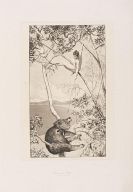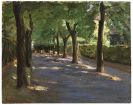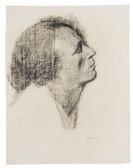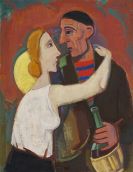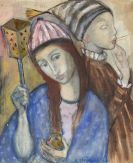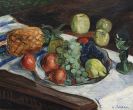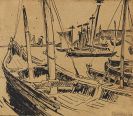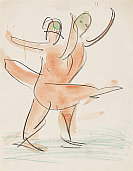
Max Klinger
Leipzig
1857 -
Großjena
1920
Max Klinger was one of the last great "artist princes" of the late 19th and early 20th centuries. In 1874 Klinger began his studies at the Grand Ducal Baden Art School in Karlsruhe, continuing from 1875 at the Royal Academy of Art in Berlin under Karl Gussow. Klinger completed his studies with the evaluation "exceptional" and a silver medal. At that time Klinger's role model as an artist was Adolph Menzel.
In 1878 Klinger showed work for the first time publicly at the 52nd Academy Exhibition in Berlin. The following year Max Klinger became a pupil of Emile Charles Wauters' in Brussels. In 1880 he painted the "Eva und die Zukunft (Opus III)" ["Eve and the Future (Opus III)"] cycle.
A year later Max Klinger opened a studio in Berlin, where he soon became a member of the Berlin Artists' Association. In 1883 Klinger received his first large commission: to decorate the vestibule of Julius Albers' villa. That same year Klinger acquired a Paris studio and devoted himself to studying the work of Goya and Daumier in the Louvre but he was most attracted by the work of Puvis de Chavannes. On his return to Berlin, Klinger met Arnold Böcklin in 1887.
Numerous trips to Italy, Brussels, Paris, Greece, London and Munich shaped the years that followed. In 1893 Klinger returned to his native Leipzig. Max Klinger grew successful, becoming a member of the Munich Academy. The Dresden Paintings Gallery became the first museum to buy one of his pictures ("Pietà") and he was appointed professor at the Royal Academy of the Graphic Arts in Leipyig and made a member of the newly founded Vienna Secession.
The idea of the "Gesamtkunstwerk" (total work of art) informed Klinger's aesthetic preoccupation with literature, sculpture, painting and drawing as well as his interest in music. The graphic arts also figure prominently in the work of this versatile and extremely prolific artist.
Max Klinger promoted the artistic dialogue of his day by founding the Villa Romana and the Association of Annual Leipzig Exhibitions. The numerous distinctions Klinger was awarded (being made a Knight of the Pour le mérite order, an honorary member of the Stockholm Academy, etc) not only attest to his success but also indicate the seminal role Klinger played in introducing modern art to Germany.
The work, stylistically a blend of Jugendstil and Symbolism, for which Klinger is chiefly remembered today includes dreamlike cycles of prints and sculpture, highly controversial during his lifetime, such as the "Beethoven" monument.
Would you like to sell a work by Max Klinger?
Infos for seller
